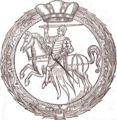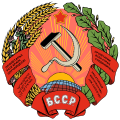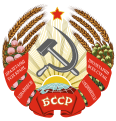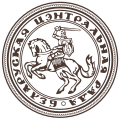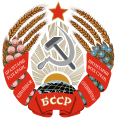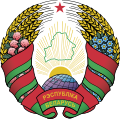Coat of arms of Belarus
| Coat of arms of Belarus | |
|---|---|

|
|
| Details |
The coat of arms of Belarus in its current form was adopted in a referendum in 1995 . The unclearly formulated question was asked on the ballot whether the "old" or "previous" insignia (i.e. coat of arms and flag ) should be used, although it was not necessarily clear whether "old" and "previous" were the old arms of the Grand Duchy of Lithuania and the white-red-white flag were meant or the symbols from the time of the Soviet Union and the Belarusian SSR that were used before the “turning point” .
The coat of arms currently in use is similar to that used during the Soviet era.
The old coat of arms of the Grand Duchy of Lithuania has been under unofficial prohibition since 1995 and is now a symbol of resistance against the government of Aljaksandr Lukashenka alongside the white, red and white national flag .
The biggest difference to the state coat of arms of the Soviet Union is that the hammer and sickle have been replaced by an outline of the Belarusian national territory. The second difference is that the banner contains the name of the nation translated as “Republic of Belarus”, as opposed to the former “Byelorussian SSR”.
The rising sun over the globe, with long rays of sunshine, was adopted. There is a star at the top. A woven banner made of wheat and flowers forms the edge of the coat of arms , similar to the banner in the red and green national flag introduced in 1995.
In 2020 the coat of arms was slightly modified again. The globe now shows more of Europe and less of Asia, the red star has been changed a bit and the outlines of the country have been enlarged. In addition, the colors have been adjusted and wheat, clover and flax are more realistic.
Historical coat of arms
Coat of arms of the short-lived Belarusian People's Republic from 1918
Coat of arms of the Belarusian Soviet Socialist Republic from 1919 to 1927
Coat of arms of the Beloruthenian Central Council from 1943 to 1944
The so-called Pahonja as the former coat of arms of the Republic of Belarus from 1991 to 1995
See also
literature
- Dmitri Semuschin: Coat of arms and state symbolism of the Belarusians from the Middle Ages to the present day. In: Dietrich Beyrau , Rainer Lindner (Hrsg.): Handbook of the history of Belarus. Vandenhoeck & Ruprecht, Göttingen 2001, ISBN 3-525-36255-2 , pp. 49-66.
Individual evidence
- ↑ Less Russia, More Europe. Belarus' New Symbol-To-Be Raises Eyebrows. In: BelarusFeed. February 20, 2020, accessed February 29, 2020 (American English).
